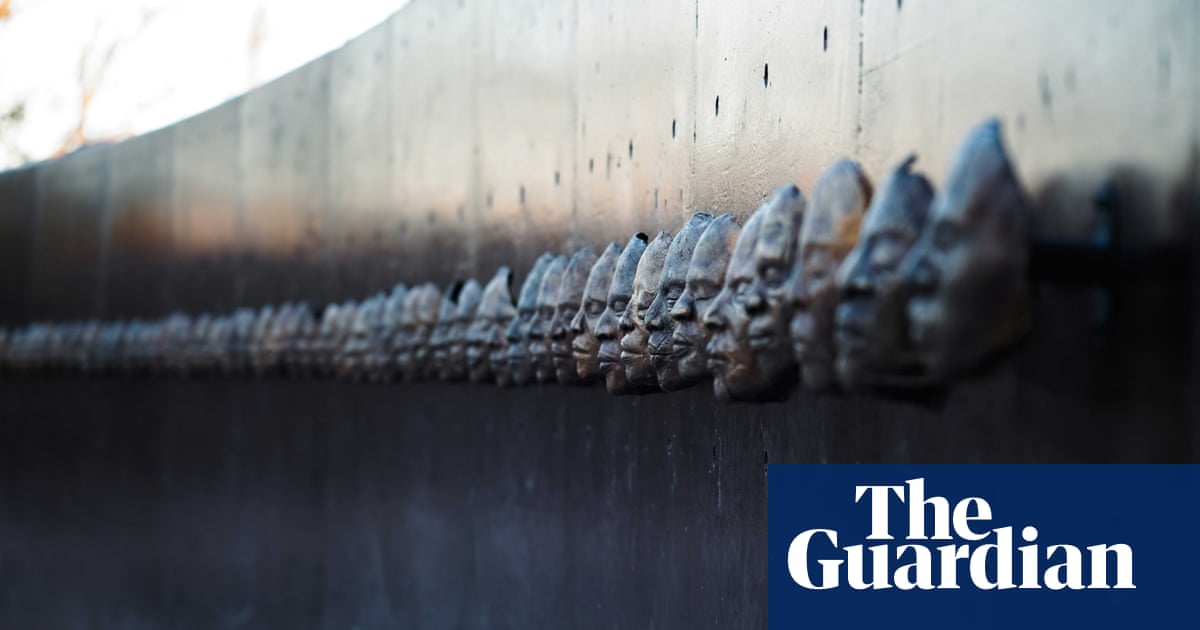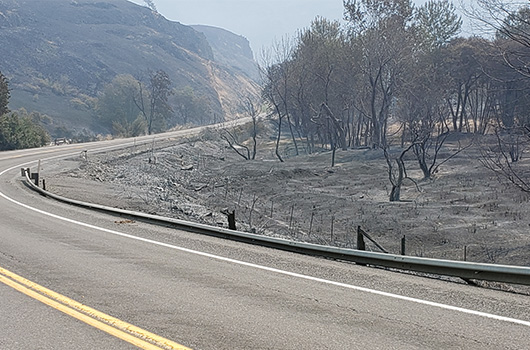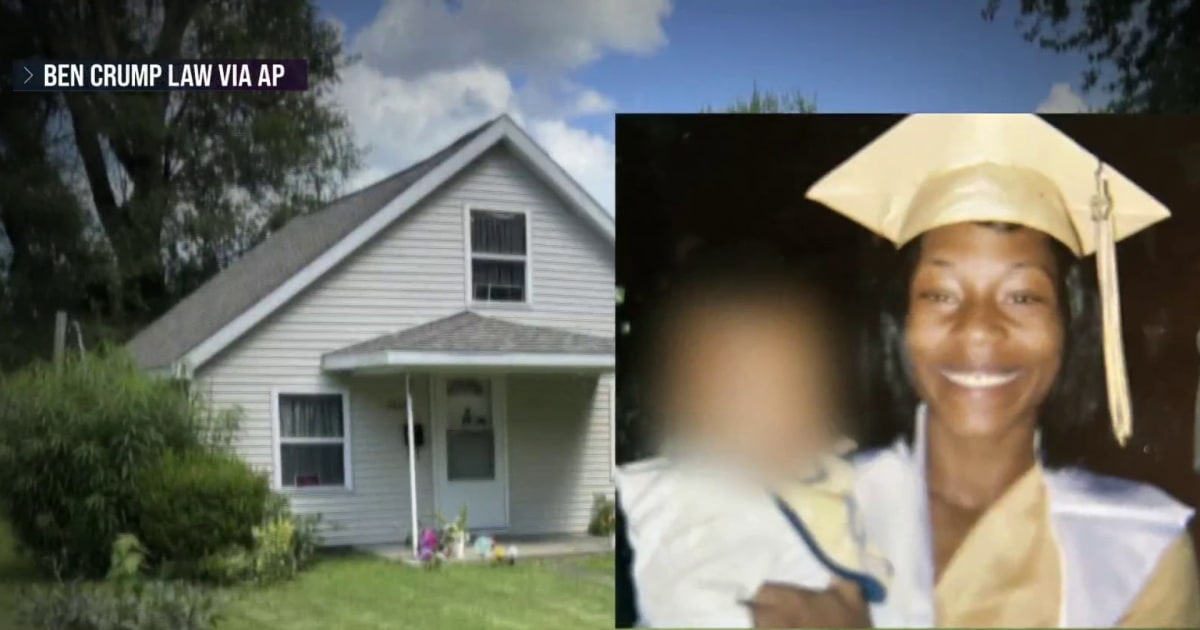Alabama
‘A narrative of triumph’: a powerful 17-acre site in Alabama remembers enslavement

âThe morning after our whipping, we all had to go to work, as if nothing had happened. I was so sore I could hardly do anything,â recalled James Matthews, who, like many enslaved people after a severe whipping, ran away into the woods. âI have known a great many who never came back; they were whipped so bad they never got well, but died in the woods, and their bodies have been found by people hunting. White men come in sometimes with collars and chains and bells, which they had taken from dead slaves. They just take off their irons and then leave them, and think no more about them.â
This quotation from Matthewsâs Recollections of Slavery by a Runaway Slave (1838) appears on a panel in the woodland setting of the Freedom Monument Sculpture Park in Montgomery, Alabama, a seamless blend of art and history opening on the banks of the Alabama River on 27 March. It is one of many first-person accounts that serve as a rebuke to historical amnesia, to deletion by indifference, to those who âthink no more about themâ. The parkâs artefacts and sculptures and its climactic monument are a radical act of remembrance rooted in a sense of place.
Whereas commemoration of the Holocaust has a locus in the Auschwitz-Birkenau Memorial and Museum and other sites across Europe, tracing the memory of the 10 million Black people enslaved in America can often feel like a succession of absences. Plantations survive but with a built environment that makes it hard to avoid the centrality of the enslaver. Countless graves and cemeteries of the formerly enslaved are buried under interstate highways, shopping malls or car parks. Some African Americans travel to west Africa in search of a tangible connection with ancestors.
The Equal Justice Initiative (EJI), a non-profit organisation that already runs the Legacy Museum and National Memorial for Peace and Justice in Montgomery, seeks to close this gap with the 17-acre site built for an estimated $12m to $15m. Visitors can arrive by boat on the same waters that once trafficked enslaved people, then step inside 170-year-old dwellings from cotton plantations as well as recreations of holding pens and railway carriages. They will hear trains running on nearby railway tracks built by enslaved hands.
Bryan Stevenson, executive director of the EJI, says in an interview: âWeâve done a poor job in America of reckoning with our history of slavery. There just arenât places people can go and have an honest encounter with that history that centres on the lives of enslaved people. In Europe, whatâs happened in Germany, in Berlin and other cities, has made Holocaust memorials and sites of remembrance such powerful places. When you go to the camps, itâs hard to avoid the power and the weight of that history.
âWeâve avoided confronting the weight of our history in ways that have undermined our ability to achieve the sort of progress and justice that many of us want. I do hope that people will come here and be sobered by the history but also inspired by the people who survived, endured, persevered and went on to commit to building an America that has so much potential.â
The river is the first artefact. Forming just north of Montgomery and flowing 318 miles, it was bordered by plantations and forced labour camps and traversed for decades by boats carrying 200 enslaved people at a time. To be trafficked south by steamship â in overcrowded conditions with little protection from the elements â was to be âsold down the riverâ .
One enslaved person forced to work on a river boat recalled: âA drove of slaves on a southern steamboat, bound for the cotton or sugar regions, is an occurrence so common, that no one, not even the passengers, appear to notice it, though they clank their chains at every step.â
Once disembarked, visitors follow a path through the sculpture parkâs native elm, oak, sycamore, cottonwood and chinaberry trees and survey art in an evocative natural landscape. Eva Oertli and Beat Huberâs 2014 concrete sculpture, The Caring Hand, presents five giant fingers protruding from the earth around a tree as the river flows beyond.
It is one of several pieces â about half of which were specially commissioned â that achieve the monumentality the space demands. At the entrance, Simone Leighâs Brick House is a 16ft-tall bronze bust of a Black woman without eyes and a torso combining the forms of a skirt and a clay house (previously seen along New York Cityâs High Line). The Ghanaian sculptor Kwame Akoto-Bamfoâs bronze We Am Very Cold depicts several figures, including a child, contorted as if in a perpetual storm. David Tanychâs steel Free at Last is an 8ft-diameter ball with a giant chain and open shackle.
Kehinde Wileyâs An Archaeology of Silence stands 17.5ft high. Invoking the visual language of heroes and martyrs in European historical art, it depicts a shirtless man in jeans and sneakers draped limply over a regal horse, acknowledging the legacy of slavery in lynchings, police brutality and other violence against Black bodies â yet with a grace and vitality that hints at resurrection.
Brad Spencerâs From the Ground Up depicts a life-size man, woman and child made entirely of brick. An accompanying panel notes that the tiny fingerprints of enslaved children who turned bricks as they dried can be seen today on the bricks of historic buildings in Charleston, South Carolina. Visitors to the park can see and touch bricks made by enslaved people 175 years ago.
The park performs a further act of excavation. For more than three centuries enslavers often decided what enslaved people were called; the US Census recorded them only with a number. After the civil war, some 4 million newly freed Black people were able to formally record a surname in the 1870 census. All 122,000 of these surnames are inscribed on the National Monument to Freedom, a 43ft-tall, 150ft-long wall angled like an open book, its concrete clad with a bronze-gold metal facade that changes with the light.
Stevenson, 64, a public interest lawyer revered for his work on prison reform and death row, comments: âThe enduring truth about enslaved people was their capacity to love, to find and create family and relationships that allowed them to survive and endure and overcome the brutality and I think that should be celebrated.
âThereâs a narrative of triumph that we need to acknowledge and the monument is a gesture toward that, as a physical space but also as a way of naming names, making personal, making human this history. For people who are descendants to come and see that name and have a tangible connection made to that legacy is important and necessary.â
There is no more fitting venue for the park than Montgomery, capital of Alabama (a state that Donald Trump won by 35 percentage points in 2020) and crucible of American contradictions. It has witnessed one of the most conspicuous slave trading communities in the nation but also an act of courage by Rosa Parks that ignited the civil rights movement (a statue of Parks marks the spot where in 1955 she boarded the bus where she would refuse to give up her seat to a white man).
On a six-acre rise overlooking the city, Stevenson built a memorial â comprising 800 corten steel monuments â to more than 4,400 Black people killed in racial terror lynchings between 1877 and 1950. But this is also a city where the Alabama state capitol (built by enslaved brickmakers and bricklayers) still features a heroic monument to the Confederacy, the breakaway southern states that fought to preserve slavery, and a statue of Jefferson Davis, inaugurated here as its first president in 1861.
Inside there are still portraits of the Confederate general Robert E Lee and Governor George Wallace, who declared in 1963: âSegregation now, segregation tomorrow, segregation forever.â Confederate banknotes are still displayed in the old treasurerâs office while eight murals inside the capitol dome still include âSecession and the Confederacy, Inauguration of President Jefferson Davis, 1861â and âWealth and Leisure Produce the Golden Period of Antebellum Life in Alabama, 1840-1860â.
Last week, at the nearby First White House of the Confederacy, a tour guide could be heard enthusing to white tourists, âYouâre on the Jefferson Davis trail!â as a Black woman entered wearing a T-shirt that said: âBut still, like air, Iâll rise â Maya Angelou.â
Rarely is the American paradox felt so keenly. In the jarring juxtaposition of progressivism versus revanchism, of the beauty of Stevensonâs vision versus the mausoleums of white supremacy, how does he avoid a permanent sense of whiplash? âWeâre in an era of transition,â he muses philosophically. âWhen I moved here in the 1980s, there were 59 markers and monuments to the Confederacy and you couldnât find the word slave, slavery or enslavement anywhere in the city landscape.
âIt was a part of a history that no one acknowledged, let alone discussed, and we are still under the cloud of a historical narrative that is false and unhealthy about the greatness of âthe lost causeâ where we romanticise this effort to preserve slavery and to maintain white supremacy. That has to be challenged and weâre going to have to move from that and youâre slowly beginning to see that.â
Until this year, Stevenson notes, the three biggest high schools in Montgomery, with student populations that are 98% Black, were named after Confederates â but not any more. âThere is some sobering around this effort to celebrate people who did horrific things, just like it would be unconscionable to go to Germany and see Adolf Hitler statues or monuments to the perpetrators of the Holocaust.
âWeâve got to reckon with the fact that we are glorifying people who were insurrectionist, tried to destroy this nation, represented a commitment to a racial order that was corrupt by this false idea that Black people are not as good as white people. With each year and each decade, weâre going to have to do more to get to a more honest space.
âThat hasnât happened in the way that it will need to happen in Alabama but it is happening. We are on that path and I donât think that we can be a schizophrenic about history. History is history and we need to reckon with it and, when we reckon with it, weâll find the courage to celebrate people â white people included â who did extraordinarily honourable things.â
Stevenson, author of the 2014 memoir Just Mercy, which became a 2019 film starring Michael B Jordan, likes to work on his historical projects covertly until they are ready to go public, thereby avoiding prejudgment by the unnerved, the resentful and the downright racist. You could call him a stealth truth bomber. The community then generally embraces his efforts, not least because they attract visitors who boost the local economy.
The Legacy Museum, which opened in 2018 and moved to a new, greatly expanded building on the site of a former cotton warehouse three years later, has few original artefacts but draws a compelling line from slavery to mass incarceration through narrative, interactive, newspaper excerpts, photos, statistics, videos, works of art and imagination. A haunting exhibit contains 800 jars of soil collected from lynching sites around the country as part of EJIâs Community Remembrance Project.
Now it is the turn of the Freedom Monument Sculpture Park to make the intangible tangible. Bricks. Names. Elms, oaks, sycamores, cottonwoods and chinaberries. A river and a railway. Love in the midst of agony. Speaking in Montgomery in 1965, Martin Luther King observed: âThe climactic conflicts always were fought and won on Alabama soil.â
Stevenson observes: âThe existence and the emergence of these truth-telling spaces allows us to say, look, if we can do this in Montgomery, Alabama, thereâs not another place in America that can say, âThey did that in Montgomery but we couldnât possibly do it here.â Thatâs the power of this place collectively because we are steeped in that long history of denial and resistance to ending slavery, to ending lynching, to ending segregation. We have an opportunity to be on the other side of this movement to commit to truth that will give us a unique credibility and power.â

Alabama
Alabama kids celebrate their hometowns in statewide art contest highlighting value of homeownership

Alabama
Death Row inmate Alan Eugene Miller: Prison too ‘incompetent’ to fit his gas mask

Alabama Death Row inmate Alan Eugene Miller said he has no intention of holding his breath or resisting his execution from nitrogen gas suffocation, but he’s worried the state will fail at securing his gas mask because they’re “incompetent.”
“I don’t think ya’ll know what you’re doing,” Miller, who would be only the second inmate in America to die by suffocating on nitrogen gas, told a state attorney during a deposition. “And these guys can’t even open a cell door sometimes. They’re keystone cops is basically what they are.”
The deposition was filed as part of an argument Miller’s lawyers made earlier this week. That filing also said the only training execution team members have for preparing an inmate for the procedure is from an Alabama Attorney General’s Office prosecutor.
Miller, 59, is set to die on Sept. 26 at William C. Holman Correctional Facility in Atmore. The prison is the only facility in the state with an execution chamber and is where most death row inmates are housed.
In a Monday filing in federal court, Miller’s attorneys said Alabama Attorney General Steve Marshall’s office and its deputy, James Houts, are “responsible for training the execution team on how to carry out a nitrogen hypoxia execution.”
Miller said he’s open to having the gas mask fitted to his face prior to his September execution, but only if a doctor, medical professional or third party appointed by a federal judge does the fitting. That’s because he believes the prison workers are “incompetent” at mask fitting.
The execution, if carried out, will be the second using nitrogen in the country. The first was also in Alabama, when the state executed Kenneth Eugene Smith in January. That execution was widely criticized, after Smith convulsed for several minutes on the gurney.
State officials have argued that Smith held his breath at the beginning of his execution, delaying the nitrogen entering his body.
“The best explanation of the testimony is that Smith held his breath and lost consciousness when he breathed nitrogen gas—not that the mask did not fit or that the nitrogen was impure,” the Alabama Attorney General’s Office said in a filing earlier this month.
Miller “has no physiological explanation for how Smith could have suffered due to the State’s nitrogen hypoxia protocol,” it said.
But on Monday, Miller’s lawyers said the state doesn’t offer any proof for their claims. The state “hang(s) their hat exclusively on the self-serving testimony of a witness who claims to have remembered Mr. Smith’s oxygen levels nearly seven months after the execution.”
The execution team captain didn’t write down those oxygen levels, according to Miller’s lawyers, nor tell anyone about them on the night of the execution.
“In fact, evidence in the record suggest that the witness could not even see the levels from his position in the execution chamber, and the execution log from Mr. Smith’s execution… undercuts (the state’s) entire argument,” said the filing.
The captain’s deposition was also submitted in public court records.
That man said his responsibility was fitting Smith with his respirator mask for the execution. “I have not encountered any person for whom the mask did not fit securely and effectively,” he said.
During Smith’s execution, the captain said he watched the “readout for one of the pulse oximeters attached to Smith’s earlobe.”
“For a period of time that was longer than I had expected, I noticed that the pulse oximeter continued to read at a steady rate of 97%-98%. I did not notice whether Smith was breathing or holding his breath during this time.”
The captain said that Smith eventually released a deep breath, and then the pulse oximeter dropped “to the low 40s in a matter of seconds.” After 40 more seconds, he said, the reading dropped to 17%.
“This rapid drop in Smith’s pulse oximeter readings was what I had expected would happen when Smith began breathing nitrogen. After those breaths, Smith’s body did not move again,” he said.
Miller’s lawyers wrote that the captain has no medical or scientific training, and had received no training for fitting gas masks. In the heavily redacted filing, the lawyers wrote that he “has never read the (REDACTED) which provides instructions on the proper fit.”
Instead, the filing said, the captain learned how to prepare inmates from state Deputy Attorney General James Houts.
“Mr. Houts has admitted he is not an expert in nitrogen hypoxia protocols, but nevertheless believes he is qualified to (REDACTED) the State’s nitrogen hypoxia system because he is a ‘private pilot, a master scuba diver,’ and served in the military.”
The filing said Houts, too, has no medical or scientific training.
All notes from the state’s execution log that were included in the filing are redacted.
Miller believes, according to his deposition earlier this month, that the state’s gas mask won’t fit him. Various masks haven’t worked on his face before, Miller said, because he has a large head and face. He’s also unable to wear hats sold to prisoners because “they are too small for his head.”
“I’ve a big old head,” he said in the deposition.
According to his Alabama Department of Corrections inmate summary, Miller weighs 351 pounds.
Miller’s team also argued the state won’t use a mask with an inherent airtight seal or perform a negative pressure test on the mask. They also said the prison system should provide Miller, or anyone about to face a nitrogen execution, a sedative to “reduce the needless suffering that occurs during asphyxiation.”
Alabama
Infant deaths up across United States, Alabama above national average

BIRMINGHAM, Ala. (WBRC) – For the first time in 20 years, more infants are dying in the United States.
A new report from the CDC shows infant mortality rates in the U.S. went up 3% in 2022.
“Infant mortality is a very good indicator of how we’re doing as a society with our healthcare, and so, the increase is always concerning whether that’s in Alabama or whether that’s nationwide,” said Dr. Wes Stubblefield with the Alabama Department of Public Health (ADPH).
ADPH says the infant mortality in the state is above the national average.
The national infant mortality rate was 5.6 deaths per thousand live births in 2022. In Alabama, ADPH says it was 6.7 deaths per thousand.
Birth defects and sudden infant death syndrome are major factors.
Stubblefield says there are also disparities in Alabama. More Black infants are dying.
“There’s a lot of reasons that go into that, some of it has to do with healthcare access,” the doctor said.
Of the 14 states that enacted near-total abortion bans in 2022, like Alabama, all but two states had a higher-than-average infant mortality rate that same year.
However, Alabama is seeing some improvement.
ADPH says infant mortality was lower in 2022 than the previous year and says it continues to work with the Governor’s Office and the State Legislature to secure funding.
“Home visiting programs, promoting safe sleep awareness through education, using screening to ensure that mothers who are identified that have substance abuse disorders are referred for treatment,” Stubblefield said.
County-by-county infant mortality rates from ADPH can be viewed here.
Get news alerts in the Apple App Store and Google Play Store or subscribe to our email newsletter here.
Copyright 2024 WBRC. All rights reserved.
-

 World1 week ago
World1 week agoOne dead after car crashes into restaurant in Paris
-

 Midwest1 week ago
Midwest1 week agoMichigan rep posts video response to Stephen Colbert's joke about his RNC speech: 'Touché'
-

 News1 week ago
News1 week agoVideo: Young Republicans on Why Their Party Isn’t Reaching Gen Z (And What They Can Do About It)
-

 Movie Reviews1 week ago
Movie Reviews1 week agoMovie Review: A new generation drives into the storm in rousing ‘Twisters’
-

 News1 week ago
News1 week agoIn Milwaukee, Black Voters Struggle to Find a Home With Either Party
-

 Politics1 week ago
Politics1 week agoFox News Politics: The Call is Coming from Inside the House
-

 News1 week ago
News1 week agoVideo: J.D. Vance Accepts Vice-Presidential Nomination
-

 World1 week ago
World1 week agoTrump to take RNC stage for first speech since assassination attempt















